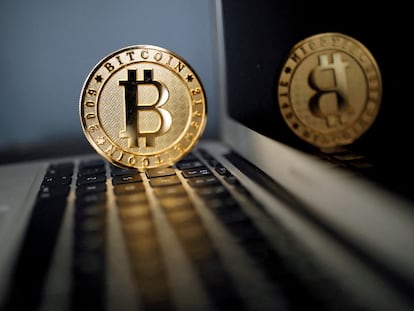Gold joins bitcoin to reach all-time highs
The precious metal has become a safe-haven asset driven by Chinese demand and a potential stock market correction

Bitcoin failed to become a safe-haven asset in 2022 because of increasing interest rates and financial turmoil. Although scandals and bankruptcies like TerraLuna and FTX raised concerns about its investment value, bitcoin has recently hit new record highs. This parallels gold’s performance, but bitcoin hasn’t fully established itself as a safe-haven asset like gold.
On March 6, the price of bitcoin brushed $70,000, surpassing its previous record from November 2021 during the pandemic. Gold also hit a new all-time high at $2,145.37, exceeding last December’s record. Bitcoin has surged 50% year-to-date, boosted by the SEC’s approval of the first bitcoin exchange-traded funds (ETFs) in the U.S.
The money flowing into these bitcoin-replicating vehicles is rapidly increasing, fueling the rally in its price. The anticipation of lower interest rates this year also played a role, though to a lesser extent. Lower rates are expected to boost investors’ risk appetite, even if the cuts come later in 2024 and are smaller than anticipated.
Interest rate cuts also benefit the price of gold, a key asset in many portfolios this year. A weaker dollar and lower rates favor investing in gold. Lower rates reduce the opportunity cost of gold compared to bonds. Despite cooling expectations for interest rate cuts, gold hit a new high.
Swiss wealth management firm Julius Baer doesn’t see any fundamental reasons to justify the rise in gold. The firm notes that the dollar and U.S. bonds have been relatively stable recently, contrary to typical safe-haven trends. They suggest that “gold seems to have been influenced by bitcoin, its digital counterpart.”
But there is another reason that justifies the appreciation of gold, which is up 5% in the last five trading sessions: it is the ultimate safe-haven asset. This is a very different reason compared to the buying frenzy surrounding bitcoin, a crypto asset that, despite the newly launched ETFs, still raises concern in the financial world. The European Central Bank (ECB) has argued that bitcoin has no real value.
Gold is being driven by increasing demand from Chinese consumers following steep declines in the country’s real estate and stock markets. Moreover, gold is solidifying its safe-haven status amid geopolitical tensions like the wars in Ukraine and Gaza, alongside surging stock markets. According to Citi, investors appear to be increasingly anticipating a recession in the U.S. by the end of the second quarter, against a backdrop of rising inflation in the real estate and service sectors. This could favor gold as a hedge against risk and macroeconomics, particularly given recent spikes in equity and credit markets. The rise in gold prices could, therefore, indicate underlying correction risks in the market. Citi predicts gold prices could reach $2,300 within six to 12 months.
Gold purchases by central banks are also supporting its price, a trend seen last year, especially among emerging countries. “Central banks around the world bought 1,037 tons in 2023, the second-highest annual total ever recorded,” said Ned Naylor-Leyland, gold and silver investment manager at Jupiter Asset Management. He is optimistic that the outflows from gold ETFs (currently negative) will reverse with money inflows “once gold decisively breaks above $2,150 per ounce.”
Sign up for our weekly newsletter to get more English-language news coverage from EL PAÍS USA Edition
Tu suscripción se está usando en otro dispositivo
¿Quieres añadir otro usuario a tu suscripción?
Si continúas leyendo en este dispositivo, no se podrá leer en el otro.
FlechaTu suscripción se está usando en otro dispositivo y solo puedes acceder a EL PAÍS desde un dispositivo a la vez.
Si quieres compartir tu cuenta, cambia tu suscripción a la modalidad Premium, así podrás añadir otro usuario. Cada uno accederá con su propia cuenta de email, lo que os permitirá personalizar vuestra experiencia en EL PAÍS.
¿Tienes una suscripción de empresa? Accede aquí para contratar más cuentas.
En el caso de no saber quién está usando tu cuenta, te recomendamos cambiar tu contraseña aquí.
Si decides continuar compartiendo tu cuenta, este mensaje se mostrará en tu dispositivo y en el de la otra persona que está usando tu cuenta de forma indefinida, afectando a tu experiencia de lectura. Puedes consultar aquí los términos y condiciones de la suscripción digital.
More information
Archived In
Últimas noticias
Most viewed
- Reinhard Genzel, Nobel laureate in physics: ‘One-minute videos will never give you the truth’
- Oona Chaplin: ‘I told James Cameron that I was living in a treehouse and starting a permaculture project with a friend’
- Pablo Escobar’s hippos: A serious environmental problem, 40 years on
- Chevy Chase, the beloved comedian who was a monster off camera: ‘Not everyone hated him, just the people who’ve worked with him’
- Why we lost the habit of sleeping in two segments and how that changed our sense of time










































